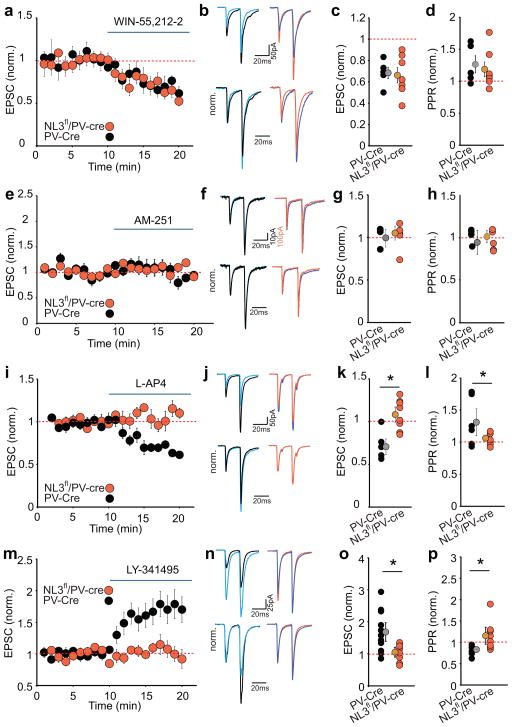Figure 3.
Increase in glutamate release caused by NL3 deletion at synapses on PV interneurons is due to loss of Group III mGluR-mediated presynaptic inhibition. (a–d) The depression of excitatory synaptic transmission in PV interneurons by the CB1 receptor agonist WIN 55,212-2 (5 μM) is not affected by NL3 deletion. Time course of normalized AMPAR EPSCs during application of WIN 55212-2 (a) and sample EPSCs in response to paired pulse stimulation before and after WIN 55212-2 application (b) in PV-Cre (before-black, after-blue) and NL3fl/PV-Cre (before-orange, after-blue) neurons. Summary plot of normalized EPSC changes due to WIN 55212-2 (c) and normalized PPR changes (d) in individual cells (PV-Cre, 0.68 ± 0.05, 1.3 ± 0.1, n=5; NL3fl/PV-Cre, 0.66 ± 0.07, 1.2 ± 0.1 n=7). e–h. Same as a-d but for effect of CB1-R antagonist AM251 (10 μM). Representative EPSCs (f) before and after AM251 for PV-Cre cell (before-black, after-blue) and NL3fl/PV-Cre (before-orange, after-blue). Individual normalized EPSC (g) and PPR (h) after AM251 application (PV-Cre, 1.0 ± 0.1, 0.9 ± 0.1, n = 5; NL3fl/PV-Cre, 1.05 ± 0.08, 1.07 ± 0.1 n = 5; p > 0.1). i–l. Same as a-d but for effect of Group III mGluR agonist L-AP4 (10 μM). Representative EPSCs (j) before and after L-AP4 for PV-Cre cell (before-black, after-blue) and NL3fl/PV-Cre (before-orange, after-blue). Individual normalized EPSC (k) and PPR (l) changes caused by L-AP4 (PV-Cre, 0.7 ± 0.1, 1.3 ± 0.1, n = 6; NL3fl/PV-Cre, 1.1 ± 0.1, 1.0 ± 0.05, n = 8; *p < 0.05). m–p, Same as i-l but for application of Group III mGluR antagonist LY341414 (1 μM) showing changes in EPSC and PPR in PV-Cre cells (1.7 ± 0.2, 0.9 ± 0.03, n = 11) and NL3fl/PV-Cre cells (1.0 ± 0.1, 1.1 ± 0.1, n = 8; *p < 0.05).

